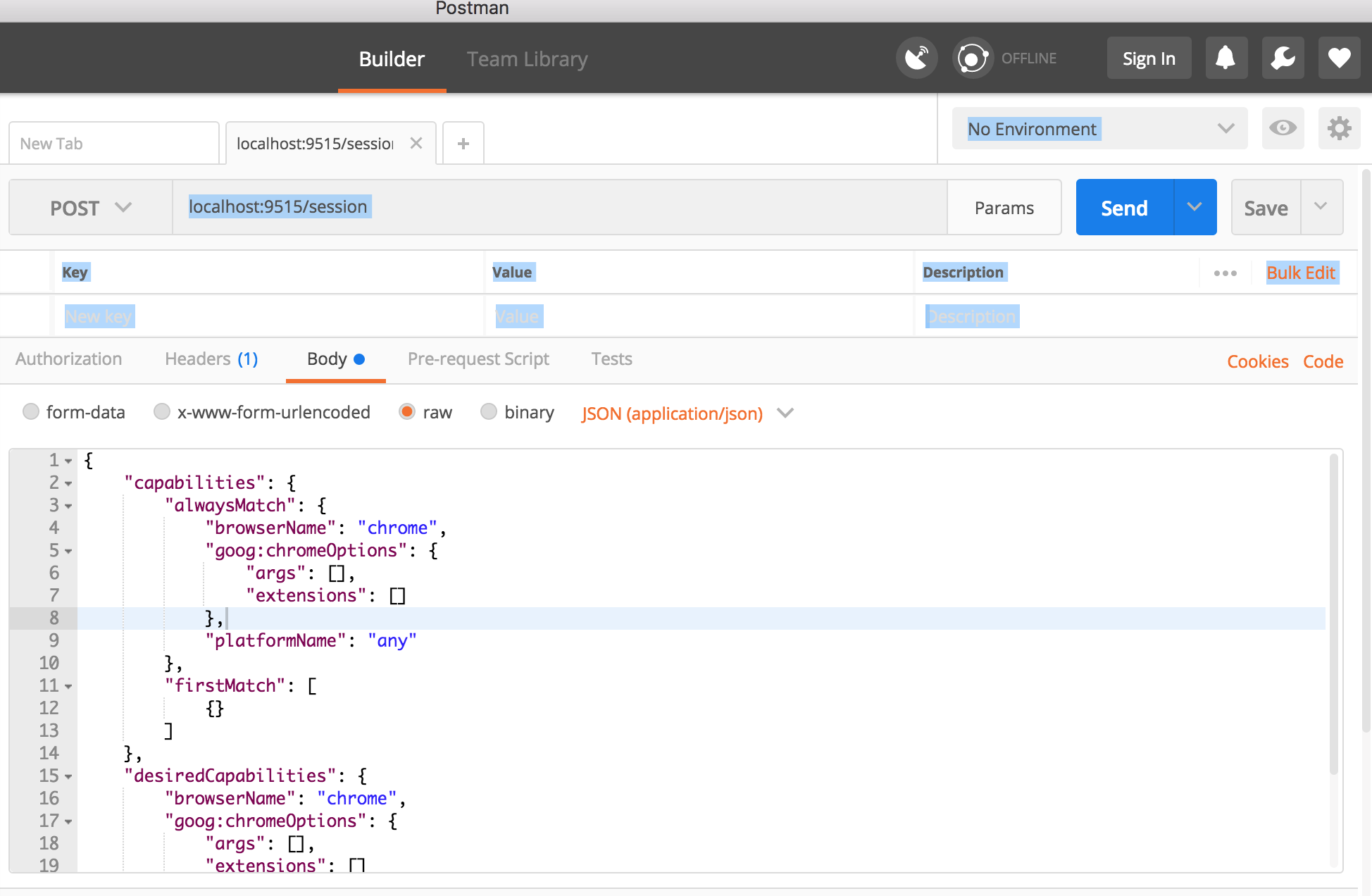前几天有同学问到selenium是怎么样启动浏览器的(selenium启动浏览器的原理),当时稍微讲解了一下,不过自我感觉不够具体,现在特地把启动原理通过代码和一系列操作给串联起来,希望可以帮助大家更好的理解。
以chrome浏览器为例,selenium启动chrome浏览器的代码如下:
def __init__(self, executable_path="chromedriver", port=0,
options=None, service_args=None,
desired_capabilities=None, service_log_path=None,
chrome_options=None):
""" Creates a new instance of the chrome driver. Starts the service and then creates new instance of chrome driver. :Args: - executable_path - path to the executable. If the default is used it assumes the executable is in the $PATH - port - port you would like the service to run, if left as 0, a free port will be found. - desired_capabilities: Dictionary object with non-browser specific capabilities only, such as "proxy" or "loggingPref". - options: this takes an instance of ChromeOptions """
if chrome_options:
warnings.warn('use options instead of chrome_options', DeprecationWarning)
options = chrome_options if options is None: # desired_capabilities stays as passed in
if desired_capabilities is None:
desired_capabilities = self.create_options().to_capabilities() else: if desired_capabilities is None:
desired_capabilities = options.to_capabilities() else:
desired_capabilities.update(options.to_capabilities()) self.service = Service(
executable_path,
port=port,
service_args=service_args,
log_path=service_log_path) self.service.start() try:
RemoteWebDriver.__init__( self,
command_executor=ChromeRemoteConnection(
remote_server_addr=self.service.service_url),
desired_capabilities=desired_capabilities) except Exception: self.quit() raise
self._is_remote = False其中跟浏览器启动密切相关的是这几句
self.service = Service( executable_path, port=port, service_args=service_args, log_path=service_log_path)self.service.start()
通过查看跟Service相关的代码复盘得到启动逻辑: 调用chromedriver可执行文件运行chromedirver。这也是为什么我们需要把chromedriver放到系统PATH里的原因。
所以selenium先启动了chromedriver。当然,我们可以手工启动chromedriver来模拟这个启动过程。
在命令行中运行下面的命令chromedirver
你应该可以看来类似的结果
Starting ChromeDriver 2.38.552518 (183d19265345f54ce39cbb94cf81ba5f15905011) on port 9515Only local connections are allowed.
这样我们就手工启动了chromedriver。driver监听的端口是9515.
启动了driver之后,我们需要告诉driver打开浏览器。selenium的源码里这一过程如下
def start_session(self, capabilities, browser_profile=None):
""" Creates a new session with the desired capabilities. :Args: - browser_name - The name of the browser to request. - version - Which browser version to request. - platform - Which platform to request the browser on. - javascript_enabled - Whether the new session should support JavaScript. - browser_profile - A selenium.webdriver.firefox.firefox_profile.FirefoxProfile object. Only used if Firefox is requested. """
if not isinstance(capabilities, dict): raise InvalidArgumentException("Capabilities must be a dictionary") if browser_profile: if "moz:firefoxOptions" in capabilities:
capabilities["moz:firefoxOptions"]["profile"] = browser_profile.encoded else:
capabilities.update({'firefox_profile': browser_profile.encoded})
w3c_caps = _make_w3c_caps(capabilities)
parameters = {"capabilities": w3c_caps, "desiredCapabilities": capabilities}
response = self.execute(Command.NEW_SESSION, parameters) if 'sessionId' not in response:
response = response['value'] self.session_id = response['sessionId'] self.capabilities = response.get('value') # if capabilities is none we are probably speaking to
# a W3C endpoint
if self.capabilities is None: self.capabilities = response.get('capabilities') # Double check to see if we have a W3C Compliant browser
self.w3c = response.get('status') is None
self.command_executor.w3c = self.w3c这一过程的核心就是就是向localhost:9515/session发送1个POST请求,并发送1个json对象,默认情况下,这个对象应该是下面这个样子。
{
"capabilities": {
"alwaysMatch": {
"browserName": "chrome",
"goog:chromeOptions": {
"args": [],
"extensions": []
},
"platformName": "any"
},
"firstMatch": [
{}
]
},
"desiredCapabilities": {
"browserName": "chrome",
"goog:chromeOptions": {
"args": [],
"extensions": []
},
"platform": "ANY",
"version": ""
}
}简单理解就是告诉remote driver打开什么浏览器,上面的例子里我们打开的是chrome浏览器。
我们可以手工还原这个过程。
确保chromedriver是在运行中的,然后打开postman,构造1个POST请求,路径是localhost:9515/session。在Body里选择raw和JSON(application/json), 贴入上面的json字符串,如下图所示

点击send,几秒之后chrome浏览器应该可以正常启动,并且postman的response里会有大致如下的返回值
{
"sessionId": "ad4407e133cfd5f3f49bff4c2f1f087a",
"status": 0,
"value": {
"acceptInsecureCerts": false,
"acceptSslCerts": false,
"applicationCacheEnabled": false,
"browserConnectionEnabled": false,
"browserName": "chrome",
"chrome": {
"chromedriverVersion": "2.38.552518 (183d19265345f54ce39cbb94cf81ba5f15905011)",
"userDataDir": "/var/folders/s6/f2_brc114wv2g8w0qggk_m2c0000gn/T/.org.chromium.Chromium.NMsAKJ"
},
"cssSelectorsEnabled": true,
"databaseEnabled": false,
"handlesAlerts": true,
"hasTouchScreen": false,
"javascriptEnabled": true,
"locationContextEnabled": true,
"mobileEmulationEnabled": false,
"nativeEvents": true,
"networkConnectionEnabled": false,
"pageLoadStrategy": "normal",
"platform": "Mac OS X",
"rotatable": false,
"setWindowRect": true,
"takesHeapSnapshot": true,
"takesScreenshot": true,
"unexpectedAlertBehaviour": "",
"version": "66.0.3359.181",
"webStorageEnabled": true
}
}上面的返回里最重要的就是sessionId,因为后面所有跟浏览器的交互都是基于该id进行的。
总结
selenium里,selenium client先打开chromedriver
chromedirver创建session时打开了浏览器,所以浏览器的打开跟selenium无关,完全是chromedriver的能力
更多
其实上面的例子里我们手工调用了webdriver协议里的new session协议,创建了webdriver session。具体的细节大家可以参考协议了解更多。

 随时随地看视频
随时随地看视频




